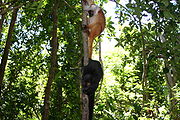
Black Lemur
Encyclopedia
The Black Lemur is a species of lemur
from the family Lemuridae
. Like all lemurs, it is endemic to Madagascar
. Originally, the species was thought to have two subspecies, Eulemur macaco macaco and Eulemur macaco flavifrons, both of which were elevated to species status by Mittermeier et al. in 2008 to Eulemur macaco and Eulemur flavifrons respectively.
Sclater's Lemur E. flavifrons has blue eyes, the only primate other than humans which has blue eyes, while E. macaco has brown or orange eyes, and ear tufts.
Both species live in northwest Madagascar. E. macaco occurs in moist forests in the Sambirano region of Madagascar and on nearby islands. E. flavifrons is restricted to the Sahamalaza Peninsula and adjacent forests. There are reports of the two species hybridizing where their ranges overlap in Manongarivo Special Reserve.
The Black Lemur displays sexual dimorphism
in coloration. Males have black or dark chocolate fur, while females' fur is of a lighter brown color, generally medium brown, chestnut brown or even orange-brown. Males of E. m. macaco have large black ear tufts, while females of E. m. macaco have large white ear tufts.
The only other Eulemur species that occur within the range of the Black Lemur are the Common Brown Lemur
, E. fulvus, which overlaps with E. macaco at the extreme southern and eastern edge of its range, and the Red-bellied Lemur
, E. rubriventer, on the Tsaratanana Massif. E. fulvus and E. rubriventer have different coloration and do not show the extreme sexual dimorphism of E. macaco, making confusion between the Black Lemur and the species unlikely.
 The Black Lemur lives in both primary and secondary forest
The Black Lemur lives in both primary and secondary forest
. It is active both during the day and at night. It forages in both the upper and middle canopy, especially at night, and during the day it also forages in the understory. In degraded habitats, it also forages on the ground and may even eat soil.
The Black Lemur lives in groups of 2 to 15 members, including approximately equal numbers of males and females. Average group size is about 10 members, although the average may be smaller for E. m. flavifrons. Females are dominant over males, although intragroup fighting is rare.
Groups have home ranges of about 3.5 to 7 hectare
s. Ranges overlap considerably, and population density can reach 200 individuals per square kilometer.
Black lemurs also have a habit of picking up and biting at toxic millipedes. The toxins are usually not fatal to the lemurs and they try to stimulate the millipede to release its toxins in self defence. Once this is achieved the black lemur will rub the millipede around its body to get the toxins on its fur. Its believed that they do this to help repel insects with the millipedes poison. However other researchers have theorized that they may also do this for a source of pleasure. Because when they inhale or swallow too much of the toxins it inhibits their monoamine oxidase
system and as a result gives them a high sensation.
of about 125 days, a single infant is usually born between late August and early October. Females typically give birth for the first time at 2 years of age.
Lemur
Lemurs are a clade of strepsirrhine primates endemic to the island of Madagascar. They are named after the lemures of Roman mythology due to the ghostly vocalizations, reflective eyes, and the nocturnal habits of some species...
from the family Lemuridae
Lemuridae
Lemuridae is a family of prosimian primates native to Madagascar, and one of five families commonly known as lemurs. These animals were thought to be the evolutionary predecessors of monkeys and apes, but this is no longer considered correct...
. Like all lemurs, it is endemic to Madagascar
Madagascar
The Republic of Madagascar is an island country located in the Indian Ocean off the southeastern coast of Africa...
. Originally, the species was thought to have two subspecies, Eulemur macaco macaco and Eulemur macaco flavifrons, both of which were elevated to species status by Mittermeier et al. in 2008 to Eulemur macaco and Eulemur flavifrons respectively.
Sclater's Lemur E. flavifrons has blue eyes, the only primate other than humans which has blue eyes, while E. macaco has brown or orange eyes, and ear tufts.
Both species live in northwest Madagascar. E. macaco occurs in moist forests in the Sambirano region of Madagascar and on nearby islands. E. flavifrons is restricted to the Sahamalaza Peninsula and adjacent forests. There are reports of the two species hybridizing where their ranges overlap in Manongarivo Special Reserve.
Physical description
The Black Lemur is between 90 and 110 centimeters in length, of which 51-65 centimeters are tail. Weight typically ranges between 1.8 and 2.0 kilograms.The Black Lemur displays sexual dimorphism
Sexual dimorphism
Sexual dimorphism is a phenotypic difference between males and females of the same species. Examples of such differences include differences in morphology, ornamentation, and behavior.-Examples:-Ornamentation / coloration:...
in coloration. Males have black or dark chocolate fur, while females' fur is of a lighter brown color, generally medium brown, chestnut brown or even orange-brown. Males of E. m. macaco have large black ear tufts, while females of E. m. macaco have large white ear tufts.
The only other Eulemur species that occur within the range of the Black Lemur are the Common Brown Lemur
Common Brown Lemur
The common brown lemur , or brown lemur, is a species of lemur in the Lemuridae family. It is found in Madagascar and Mayotte.-Range:...
, E. fulvus, which overlaps with E. macaco at the extreme southern and eastern edge of its range, and the Red-bellied Lemur
Red-bellied Lemur
The Red-bellied Lemur is a medium sized prosimian with a luxuriant chestnut brown coat. This lemur is endemic to eastern Madagascan rainforests and is distinguished by patches of white skin below the eyes, giving rise to a "teardrop" effect, particularly conspicuous in the male.The species, first...
, E. rubriventer, on the Tsaratanana Massif. E. fulvus and E. rubriventer have different coloration and do not show the extreme sexual dimorphism of E. macaco, making confusion between the Black Lemur and the species unlikely.
Diet
The Black Lemur primarily eats fruit, which makes up an estimated 78% of is diet. The ripeness of this fruit is vital to the lemur's diet. Other foods eaten include flowers, leaves, fungi, some invertebrates and, especially during the dry season, nectar.Behavior

Secondary forest
A secondary forest is a forest or woodland area which has re-grown after a major disturbance such as fire, insect infestation, timber harvest or windthrow, until a long enough period has passed so that the effects of the disturbance are no longer evident...
. It is active both during the day and at night. It forages in both the upper and middle canopy, especially at night, and during the day it also forages in the understory. In degraded habitats, it also forages on the ground and may even eat soil.
The Black Lemur lives in groups of 2 to 15 members, including approximately equal numbers of males and females. Average group size is about 10 members, although the average may be smaller for E. m. flavifrons. Females are dominant over males, although intragroup fighting is rare.
Groups have home ranges of about 3.5 to 7 hectare
Hectare
The hectare is a metric unit of area defined as 10,000 square metres , and primarily used in the measurement of land. In 1795, when the metric system was introduced, the are was defined as being 100 square metres and the hectare was thus 100 ares or 1/100 km2...
s. Ranges overlap considerably, and population density can reach 200 individuals per square kilometer.
Black lemurs also have a habit of picking up and biting at toxic millipedes. The toxins are usually not fatal to the lemurs and they try to stimulate the millipede to release its toxins in self defence. Once this is achieved the black lemur will rub the millipede around its body to get the toxins on its fur. Its believed that they do this to help repel insects with the millipedes poison. However other researchers have theorized that they may also do this for a source of pleasure. Because when they inhale or swallow too much of the toxins it inhibits their monoamine oxidase
Monoamine oxidase
L-Monoamine oxidases are a family of enzymes that catalyze the oxidation of monoamines. They are found bound to the outer membrane of mitochondria in most cell types in the body. The enzyme was originally discovered by Mary Bernheim in the liver and was named tyramine oxidase...
system and as a result gives them a high sensation.
Reproduction
Mating usually takes place in April and May. During mating season, antagonism between males increases, and males sometimes roam between groups. After a gestationGestation
Gestation is the carrying of an embryo or fetus inside a female viviparous animal. Mammals during pregnancy can have one or more gestations at the same time ....
of about 125 days, a single infant is usually born between late August and early October. Females typically give birth for the first time at 2 years of age.

